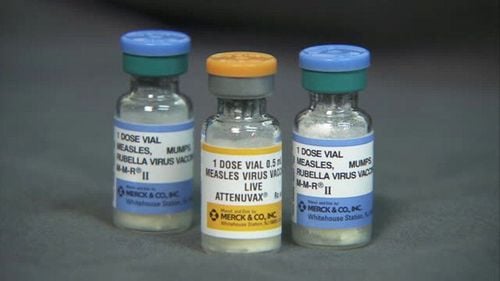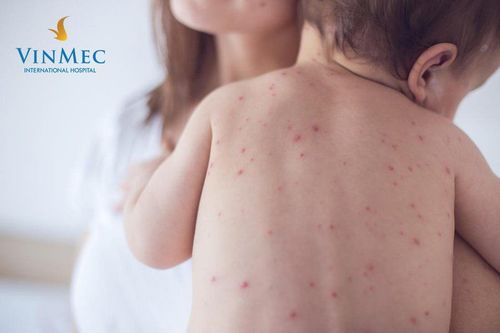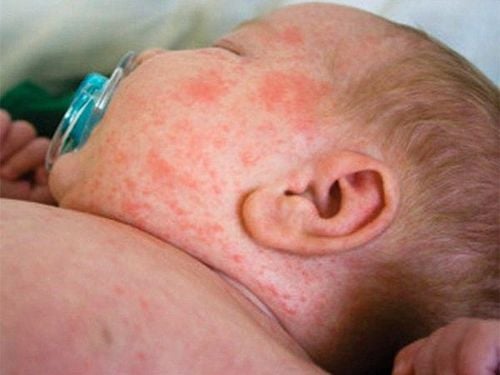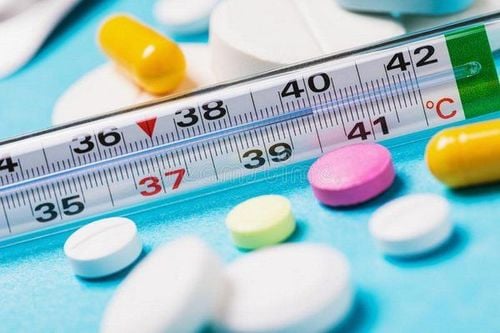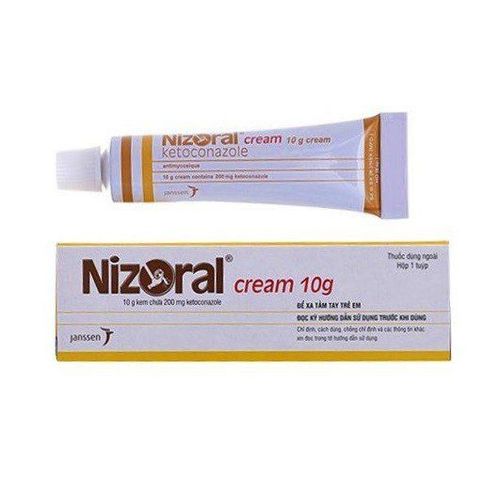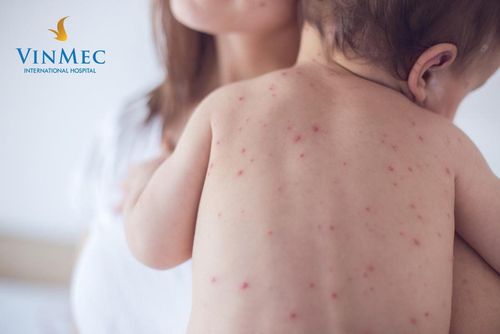This is an automatically translated article.
The article was professionally consulted by Specialist Doctor II Le Thanh Cam - Department of Pediatrics - Neonatology - Vinmec Danang International General Hospital. Uncle has 15 years of experience in diagnosis & treatment of pediatric diseases; She used to work at the Pediatric Department - Da Nang Hospital and Da Nang Center for Obstetrics and Gynecology. Her strength is diagnosis and treatment of pediatric diseases; resuscitation, pediatric emergency.
When having typhus, children often have obvious mental state changes such as crying, ... Then, children have fever, runny nose, cough, some children also have diarrhea, a few days later , began to appear red spots on the body. Although typhus is benign, if understood and treated incorrectly, it will lead to dangerous complications.
1. What causes typhus in children?
Typhus in children or adults is usually caused by the rubella virus (also known as rubella) and the measles virus (also called scarlet fever). The rubella rash is usually thicker and lighter in color than the measles rash, the virus that causes rubella is quite benign in children but very dangerous for pregnant women. Measles rash (erythema) is a papule rash (a raised rash on the skin), which, when gone, leaves a very characteristic dark spot on the skin commonly known as "tiger stripes".
The cause of the disease is the transmission of the virus from person to person through physical contact with infected people or their personal items.
The general manifestation of typhus in children is that after an incubation period of about a week, children often have a fever, which can be mild fever from 37.5 degrees C - 38 degrees C or high fever from 39 degrees C - 40 degrees C, depending on the condition and cause of the disease, when the fever subsides, erythema will appear on the body with specific characteristics of each disease, specifically as follows:
Measles virus rash (erythema): The onset of the disease Children often have fever, when the signs of fever decrease, there will be signs of a rash, first behind the ears, then spreading to the face, then gradually spreading to the chest, abdomen and the whole body. When the measles rash disappears, it will also fade in the order it appeared on the skin, the characteristic of the measles rash is a papule rash, raised on the skin, when it flies, it will leave very characteristic bruises on the skin often called "striated skin" tiger". Measles is often accompanied by symptoms such as a runny nose, cough, or red eyes. Rubella virus rash (rosacea): a rash that begins on the face and then spreads to the legs, the rash usually lasts about 3 days. The rubella rash is usually thicker and lighter in color than the measles rash, and may be accompanied by swelling of the posterior auricular, cervical, and suboccipital lymph nodes, and joint pain may be present.
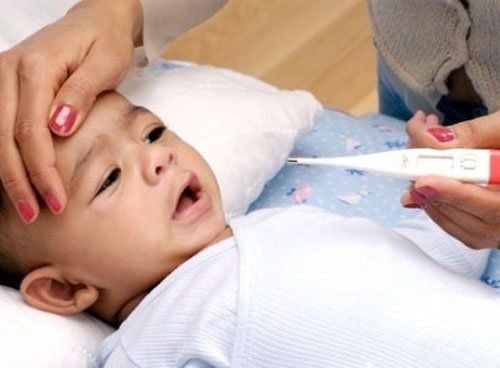
2. What to do when the child has a high fever, fusses a lot?
When there are signs of suspicion that a child has typhus, parents often go online to find information about pictures of children with typhus or children with typhus, what to do to treat them. However, the first thing that parents need to do is take their child to see a doctor for the best diagnosis and treatment. Then, treating children with typhus at home under the guidance of a doctor during the fever period is very important to help children increase their resistance and quickly reduce fever. Child care often needs to be directed towards the following goals:
Monitor the temperature and cool down when necessary:
Parents need to monitor the child's temperature regularly, cool down when necessary to make the child feel comfortable. comfortable. Paracetamol oral and rectal form is usually used for children with fever at a dose of 10mg/kg/time (4-6 hours/time) Even though the weather is winter, when the child has a fever, parents should also loosen clothes for young. During the treatment of infants with typhus, you can bathe the child clean every day, do not abstain from the wind or eat. The habit of abstaining from wind and water by covering the child, and not cleaning the body will make it difficult for the child to reduce fever and easily convulse due to high fever. Failure to clean the body will make children uncomfortable, prone to skin infections and pneumonia complications. But parents should not let the child catch a cold. Warm with a soft towel or wipe the child with a warm towel for no more than 10 minutes/hour. Only apply if the child has a high fever, the fever affects the child's activities. In addition to medication, you can use simple ways to reduce fever safely for young children such as warming the child with a towel dipped in warm water (avoid using cold water), wearing cool clothes for the child, using a blanket or using a blanket. thick for children. If your child has a cough, give them herbal cough suppressants. Clear the baby's nose with dilute saline and a soft tissue. This is a way to make it easier for babies to eat and drink breast milk. Adequate rehydration for children:
Parents should encourage children to drink a lot of water: fruit juice, soup, oresol.. When provided with enough water, usually every 4 hours the child urinates. Parents still need to monitor for abnormal signs in children: Parents still need to monitor to detect early warning signs as mentioned above to quickly take children to medical facilities if necessary. At the same time, from the time of fever until the disease is completely cured, you need to let the child rest in bed and the living environment also needs to be clean, cool, avoid moisture, secret and easy to breed bacteria.
When parents see that the child's typhus fever is > 39.4 degrees Celsius, the temperature is not controlled despite taking antipyretic drugs, after 3 days of treatment, the typhus fever has not changed positively and the children have immune systems. If the disease is weak, under 6 months old or the child is dehydrated due to diarrhea, you should take the child to the hospital for the best treatment, minimizing the risks to the child.
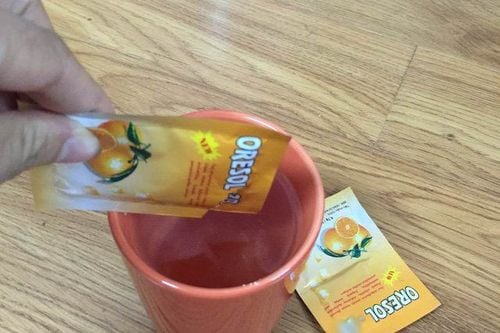
3. Prevention of typhus in children
Many patients, even though they have not yet shown signs of rash, are already infected, so it is important to avoid contact with people who are suspected of having the disease. Regularly clean the baby every day. A varied and nutritious diet, especially vitamin-rich foods, is regularly added to increase the child's resistance. When your baby shows symptoms of typhus, you should take him to a medical facility early to avoid causing dangerous complications affecting the heart and nerves. Vinmec has a full range of doctors specializing in neurology, cardiology, respiratory, digestive, oncology... right at the Department of Pediatrics, who can effectively treat typhus and complications if any quickly and accurately. Accurate, efficient, save travel time between departments. A team of experienced and highly qualified medical doctors provide the most accurate treatment regimen.
In addition, to best prevent typhus in children, you should give your baby a full vaccination. For children as young as 9 months old, you can give them vaccinations under the expanded immunization program. When your baby is 12-15 months old, you can give your baby a 3-in-1 vaccine (rubella is protected against measles and mumps). When the child is 4-6 years old, you need to give the child a second dose to increase the ability to prevent disease. Currently, Vinmec vaccination center has a full range of these vaccines. All vaccines are of high quality, of clear origin, and are safe from import, storage to use.
If you have a need to examine your baby or vaccinate, please register directly at the website or contact the hotline system for detailed advice.
Please dial HOTLINE for more information or register for an appointment HERE. Download MyVinmec app to make appointments faster and to manage your bookings easily.





